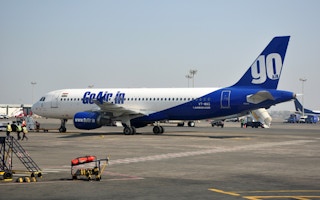Imagine how much cleaner the air would be if 3 million cars were taken off the roads in your city. A hint: Banning just half of Beijing’s 3.3 million cars before the 2008 Olympics cleared its skyline within a few days.
The world’s skies may clear in an equally dramatic fashion if the aviation industry could succeed in cutting carbon dioxide (CO2) emissions through more efficient engines, sustainable fuel and use of carbon credits.
In a recent interview with Eco-Business, Alan Epstein, Pratt & Whitney’s vice president for Technology & Environment, calculates that yearly emissions equivalent to CO2 released by 3 million cars could be avoided if all 8,000+ of Pratt & Whitney’s PurePower Geared Turbofan PW1000G engines on order were active in the skies now.
Due to its innovative geared architecture, the engine is 16 percent more fuel efficient than current engines used on most jets, resulting in huge fuel savings and reduced CO2 emissions.
“We are always looking to introduce new designs with lighter materials, and using manufacturing technologies that let us make lighter shapes than we could otherwise economically afford to. All these help to reduce the fuel burn,” says Epstein.
Pratt & Whitney’s PW1000G engines are among recent developments steering the aviation industry toward a more sustainable future.
Over the past decade, engineers have steadily broken new ground in engine design and sustainable fuel, helping to reduce emissions in an industry that already contributes 2 percent of manmade CO2 emissions worldwide, a figure that is set to grow given the rising demand for air travel.
A boost to the aviation industry’s sustainability efforts came last October, when national representatives at the International Civil Aviation Organization (ICAO) finally agreed – after years of wrangling – to a global deal to limit greenhouse gas emissions from airlines.
A centerpiece of the deal is the Carbon Offsetting and Reduction Scheme for International Aviation (CORSIA), aimed at stopping emission growth in its tracks after 2020. To be implemented in 2021 for a voluntary period, the scheme ensures any increase in CO2 emissions from aviation will be offset with activities that absorb CO2, such as investments in tree planting.
Airlines that increase emissions from the previous year will need to buy “emission units” that can be bought and sold directly through a carbon market. So, although CORSIA does not require direct emission cuts from aviation, these measures indirectly make higher carbon emissions more costly for airlines.
Lowering emissions through better engines
Creating light yet powerful engines is one of the biggest ambitions of aviation engineering. At Pratt & Whitney, engineers have spent decades pushing the technological limits of engines in a bid to improve efficiency.
Epstein says: “The trade-off is always between efficiency and weight. If I make a more efficient airplane engine that weighs more, it isn’t optimised because its carrying extra weight.”
To create light and resilient engines, Pratt & Whitney has added nanoparticles to its engine materials. Nickel-based superalloys – materials made of different metals mixed together to improve strength – are used to make engine components.
The result: New geared turbofan engines that are bigger, lighter and more fuel efficient at the same time, says Epstein. The engines are also capable of running at extreme temperatures for thousands of cycles /years.
“
The trade-off is always between efficiency and weight. If I make a more efficient airplane engine that weighs more, it isn’t optimised because its carrying extra weight.
Alan Epstein,vice president for Technology & Environment, Pratt & Whitney
Alternative engine features at KLM
At KLM Royal Dutch Airlines, fleets have been renewed as part of its plans to reduce carbon emissions by 20 per cent per passenger by 2020, compared to 2011 levels. Other measures include improving operational efficiency, using biofuel, and carbon offsetting.
KLM’s newest aircraft, the Dreamliner is equipped with a slew of improvements that has reduced its weight and improved fuel efficiency.
Two examples of innovations to lighten the Dreamliner’s engines include removing one of the heritage systems in the engine, the bleed air system, and using titanium aluminide instead of nickel alloy as material for some of the rotary blades.
“
If biofuels were to be broadly used, the reduction in CO2 could be as high as 80 percent.
Lindin Coppell, head of sustainability, Etihad Airways
Cleaner fuel
Another boost in aviation sustainability came earlier in 2011, with the commercialisation of biofuels as a replacement for jet fuel. Biofuel is a relatively cleaner option than jet fuel, and produces lower CO2 emissions.
One airline, Etihad Airways, has been making efforts to develop sustainable fuel with Boeing and Masdar Institute, a research university in the United Arab Emirates, a country along the Persian Gulf covered with desert.
According to Etihad Airways’ head of sustainability Linden Coppell, a research programme is ongoing to develop sustainable fuel feedstock on non-arable desert land with no freshwater.
Coppell says: “Our ‘seawater energy and agriculture system’ is now operating at pilot scale, with the first harvest of biomass recently. The oil from the seeds of the saltwater tolerant plant will be converted to jet fuel by Adnoc Refining for use on an Etihad commercial flight.”
Sustainable biofuel is currently the best alternative to jet fuel, a KLM spokesman tells Eco-Business, given the lack of breakthroughs in the development of solar energy and batteries for aviation use.
“If biofuels were to be broadly used, the reduction in CO2 could be as high as 80 percent. That means biofuel is more sustainable than the standard fossil fuel currently used in air transport,” he says.
The spokesman stresses that KLM only uses biofuel made from sustainable feedstock that does not have a negative impact on biodiversity or food security. To ensure this, KLM buys fuel certified by independent global organisations such as the Round Table of Sustainable Biofuels.
The future
The aviation industry has come a long way in terms of energy efficiency. At Pratt &
Whitney, improvements in engine design and technology have reduced fuel burn
and carbon emissions at a rate of 1 percent on average, annually, over the last several decades and will do so for the foreseeable future, says Epstein.
“Some people stare and say, ‘oh it’s only 1 percent a year!’. What they don’t understand is compound interest, it’s growth year upon year,” says Epstein, adding that these changes, over time, will lead to big jumps in efficiency for aircraft engines.
On reducing emissions, Coppell says that there is a ‘basket of measures’ for the industry to reduce its carbon dependence, including operational measures and by supporting infrastructure improvements.
The KLM spokesman hopes that more airlines and organisations will join hands to make air transport more sustainable. Airports need to add biofuel to their existing fuelling systems as well, he adds.
“The development of biofuels cannot just be driven by KLM and other airlines,” he says.




















